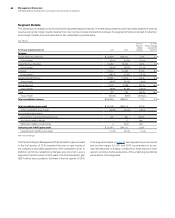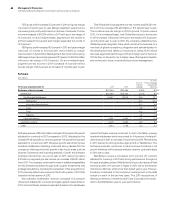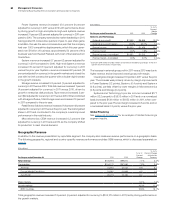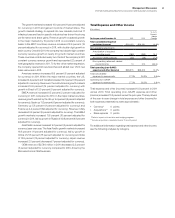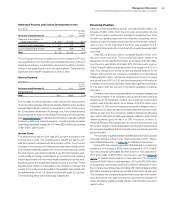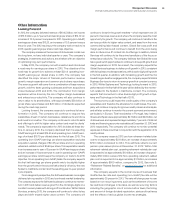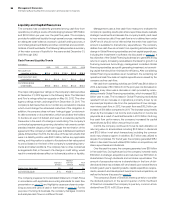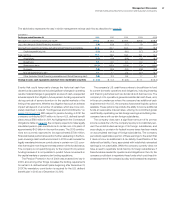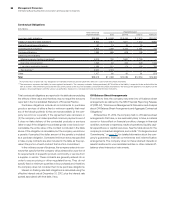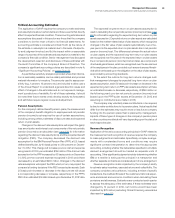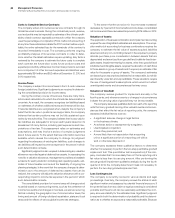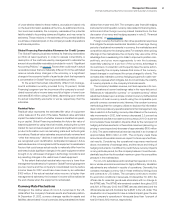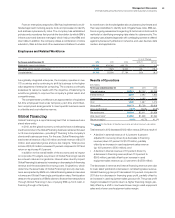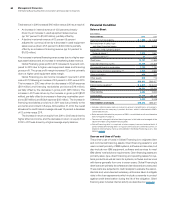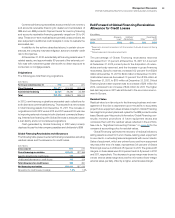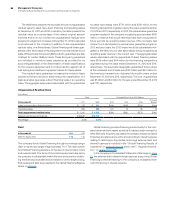IBM 2012 Annual Report Download - page 57
Download and view the complete annual report
Please find page 57 of the 2012 IBM annual report below. You can navigate through the pages in the report by either clicking on the pages listed below, or by using the keyword search tool below to find specific information within the annual report.
5656 Management Discussion
International Business Machines Corporation and Subsidiary Companies
Liquidity and Capital Resources
The company has consistently generated strong cash flow from
operations, providing a source of funds ranging between $18.8 billion
and $20.8 billion per year over the past five years. The company
provides for additional liquidity through several sources: maintaining
an adequate cash balance, access to global funding sources, a
committed global credit facility and other committed and uncommit-
ted lines of credit worldwide. The following table provides a summary
of the major sources of liquidity for the years ended December 31,
2008 through 2012.
Cash Flow and Liquidity Trends
($ in billions)
2012 2011 2010 2009 2008
Net cash from
operating activities $19.6 $19.8 $19.5 $20.8 $18.8
Cash and short-term
marketable securities $11.1 $11.9 $11.7 $14.0 $12.9
Committed global
credit facility $10.0 $10.0 $10.0 $10.0 $10.0
The major rating agencies’ ratings on the company’s debt securities
at December 31, 2012 appear in the following table. The Standard
and Poor’s ratings reflect an upgrade on May 30, 2012. The other
agency ratings remain unchanged from December 31, 2011. The
company’s debt securities do not contain any acceleration clauses
which could change the scheduled maturities of the obligation. In
addition, the company does not have “ratings trigger” provisions in
its debt covenants or documentation, which would allow the holders
to declare an event of default and seek to accelerate payments
thereunder in the event of a change in credit rating. The company’s
contractual agreements governing derivative instruments contain
standard market clauses which can trigger the termination of the
agreement if the company’s credit rating were to fall below investment
grade. At December 31, 2012, the fair value of those instruments that
were in a liability position was $503 million, before any applicable
netting, and this position is subject to fluctuations in fair value period
to period based on the level of the company’s outstanding instru-
ments and market conditions. The company has no other contractual
arrangements that, in the event of a change in credit rating, would
result in a material adverse effect on its financial position or liquidity.
Standard
& Poor’s
Moody’s
Investors
Service
Fitch
Ratings
Senior long-term debt AA- Aa3 A+
Commercial paper A-1+ Prime-1 F1
The company prepares its Consolidated Statement of Cash Flows
in accordance with applicable accounting standards for cash flow
presentation on page 73 and highlights causes and events under-
lying sources and uses of cash in that format on page 36. For the
purpose of running its business, the company manages, monitors
and analyzes cash flows in a different format.
Management uses a free cash flow measure to evaluate the
company’s operating results, plan share repurchase levels, evaluate
strategic investments and assess the company’s ability and need
to incur and service debt. Free cash flow is not a defined term under
GAAP and it should not be inferred that the entire free cash flow
amount is available for discretionary expenditures. The company
defines free cash flow as net cash from operating activities less the
change in Global Financing receivables and net capital expenditures,
including the investment in software. As discussed on page 24, a
key objective of the Global Financing business is to generate strong
returns on equity. Increasing receivables is the basis for growth in a
financing business. Accordingly, management considers Global
Financing receivables as a profit-generating investment, not as work-
ing capital that should be minimized for efficiency. After considering
Global Financing receivables as an investment, the remaining net
operational cash flow less net capital expenditures is viewed by the
company as free cash flow.
Net cash from operating activities per GAAP was $19.6 billion in
2012, a decrease of $0.3 billion from the prior year. As discussed on
page 36, a key driver was a decrease in cash provided by receiv-
ables, primarily Global Financing receivables, which increased $3.2
billion year to year. The increase in Global Financing receivables
resulted from an increase in originations primarily driven by an
improved participation rate. From the perspective of how manage-
ment views cash flow, in 2012, free cash flow was $18.2 billion, an
increase of $1.6 billion compared to 2011. The increase was primarily
driven by the increase in net income and a reduction in income tax
payments as a result of audit settlements in 2011. Within its strong
free cash flow performance, the company increased its capital
expenditures by $0.2 billion versus the prior year.
In 2012, the company continued to focus its cash utilization on
returning value to shareholders including $3.8 billion in dividends
and $10.5 billion in net stock transactions, including the common
stock repurchase program. In addition, $3.7 billion was utilized to
acquire 11 companies. For the full year, the company generated $18.2
billion in free cash flow and utilized $18.0 billion on acquisitions, net
share repurchases and dividends.
Over the past five years, the company generated over $80 billion
in free cash flow. During that period, the company invested nearly
$19 billion in strategic acquisitions and returned over $61 billion to
shareholders through dividends and net share repurchases. The
amount of prospective returns to shareholders in the form of divi-
dends and share repurchases will vary based upon several factors
including each year’s operating results, capital expenditure require-
ments, research and development investments and acquisitions, as
well as the factors discussed on page 57.
The company’s Board of Directors meets quarterly to consider
the dividend payment. In the second quarter of 2012, the Board
of Directors increased the company’s quarterly common stock
dividend from $0.75 to $0.85 per share.


